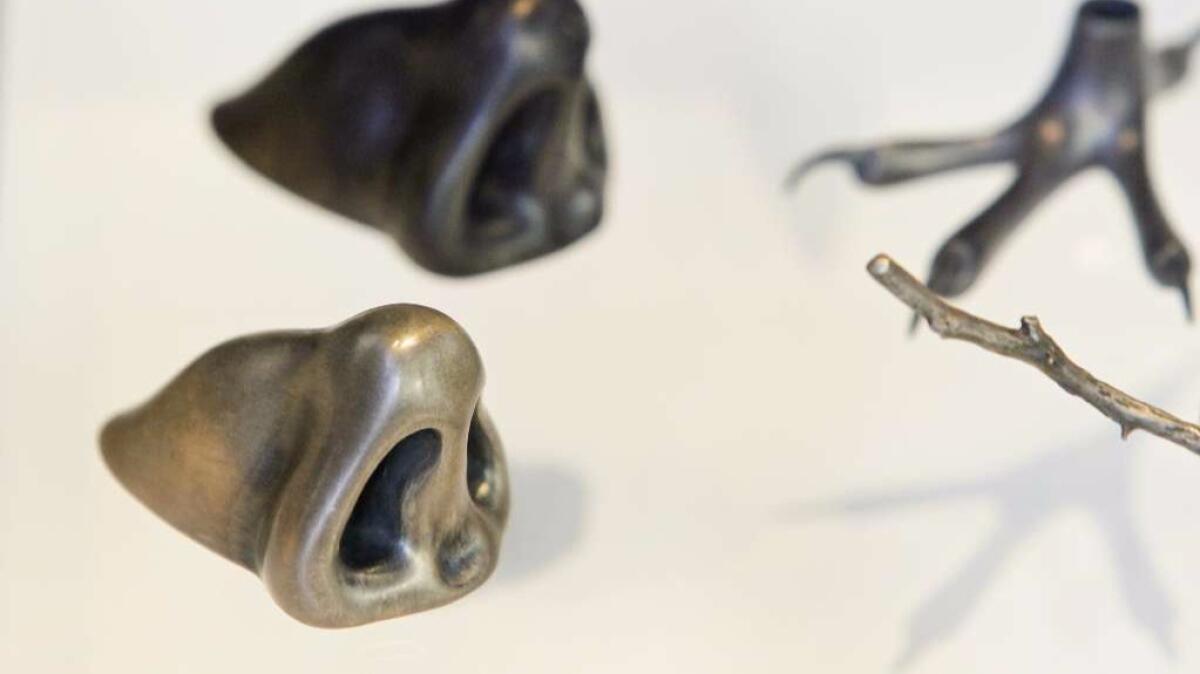Scientists find microbiotic treasure hidden in the nose

- Share via
Your mother told you early and often not to stick your finger up there. But scientists say they have reached into the human nose and picked out something really special — a potential new medicine to combat the dreaded MRSA bacteria.
If the authors of a new report have their way, teams of researchers will soon be hunting for new medicines in all kinds of other orifices of the human body, as well as deep inside the squishy confines of the gut.
Meanwhile, a team of German bacteriologists has found that the human nostril is home to a bacterium producing a compound capable of killing several variants of the disease-causing Staphylococcus aureus. Among the staph infections the newly discovered agent can vanquish: methicillin-resistant Staphylococcus aureus (MRSA), the hospital acquired infection that kills more than 11,000 U.S. patients a year and sickens another 80,500.
The nasal resident with such superpowers is called Staphylococcus lugdunensis. In a study published in the journal Nature on Wednesday, researchers said S. lugdunensis produces lugdunin, a new class of antibiotic that not only drives down the replication of S. aureus, but does not send S. aureus into a frenzy of effort aimed at resisting lugdunin’s antibiotic action.
It was totally unexpected to find a human-associated bacteria to produce an antibiotic.
— Andreas Peschel, bacteriologist at the University of Tubingen
If borne out in further studies, those claims would make lugdunin a remarkable discovery. It’s been nearly 30 years since scientists have found a new class of antibiotic. And within a few years of most new antibiotics’ introduction — often within mere months— the disease-causing bacteria they’re meant to vanquish have begun to develop resistance.
When they applied lugdunin to the skin lesion of mice who had been infected with S. aureus, bacteriologists from the University of Tubingen observed “dramatic reductions” in the lesions’ colonization with the pathogen.
Some mice saw their lesions clear completely, and the scientists observed that lugdunin penetrated the most superficial layers of diseased tissue and acted on deeper layers to clear the infection.
Many questions remain, the authors acknowledged. Not least among them is whether lugdunin, or the Staphylococcus bacterium that produces it, could itself cause disease.
That said, the fact that the novel compound was being produced by bacteria living inside the human nose is a surprising development, and suggests a largely untapped landscape for antibiotic discovery efforts. Ever since penicillin was discovered in 1928, microbiologists have traditionally looked in the soil, where bacteria live and thrive in virtually limitless variety.
“It was totally unexpected to find a human-associated bacteria to produce an antibiotic,” said Andreas Peschel, a bacteriologist at the University of Tubingen in Germany and one of the Nature study’s co-authors.
It makes perfect sense, actually. Many of the bacteria that make us sick are already present in our guts, mouths, noses or genitalia. One of the reasons they don’t sicken us is because these tracts are vast breeding grounds for competing bacteria. In this survival-of-the fittest world, every trouble-making bacterium probably has a close neighbor busily plotting its downfall, or at least keeping it in check.
In a bid to speed the discovery of new antimicrobial medicines, the discoverers of Staphylococcus lugdunensis went knocking on those neighbors’ doors to see how they were doing that.
To find lugdunin, the authors of the new research plumbed the human nasal cavity for 90 different samples of Staphylococcus, including a variety of different species from that family. Then they tested each to see if it would inhibit the growth of S. aureus.
Noting that one-in-three humans is colonized by S. aureus bacteria, Peschel called the nose “an ecosystem of, like, 50 different bacteria species.” Individuals carry widely different constellations of those bacteria, and Peschel said that his team’s study of this fecund microbiotic jungle is also leading to new insights about how disease-causing bacteria are kept in check in healthy people.
See the most-read stories in Science this hour »
Peschel also said there may be more antibiotic compounds to be discovered in there, and his team continues to explore other potential antibiotic compounds.
In a commentary published by Nature, Kim Lewis and Philip Strandwitz of Northeastern University’s Antimicrobial Discovery Center lauded the effort to find unrecognized antibiotic compounds “right under our nose.”
Genetic studies suggest the human microbiome might be a rich source of disease-fighting medicines, they wrote, since many gene clusters have been found to encode enzymes linked to antibiotic production.
“Only a few such antibiotics have been characterized in the laboratory,” they wrote. “The current study fills this gap.”
While it may take years for lugdunin to be tested in humans, the University of Tubingen has filed for commercial rights to the discovery. While the team continues to hunt for new antibiotics compounds residing inside the human body, its members expressed hope that some drug company would support lugdunin’s development for the antibiotic market.
MORE SCIENCE NEWS
Are skin-cancer checks by doctors worth the trouble?
4 in 10 top-selling sunscreens on Amazon don’t meet dermatologists’ standards, study says
Why the Rio Olympics are not likely to increase the spread of Zika across the world




